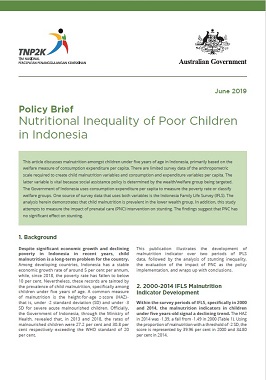Nutritional Inequality of Poor Children in Indonesia
This article discusses malnutrition amongst children under five years of age in Indonesia, primarily based on the welfare measure of consumption expenditure per capita. There are limited survey data of the anthropometric scale required to create child malnutrition variables and consumption and expenditure variables per capita. The latter variable is vital because social assistance policy is determined by the wealth/welfare group being targeted. The Government of Indonesia uses consumption expenditure per capita to measure the poverty rate or classify welfare groups. One source of survey data that uses both variables is the Indonesia Family Life Survey (IFLS). The analysis herein demonstrates that child malnutrition is prevalent in the lower wealth group. In addition, this study attempts to measure the impact of prenatal care (PNC) intervention on stunting. The findings suggest that PNC has no significant effect on stunting.
